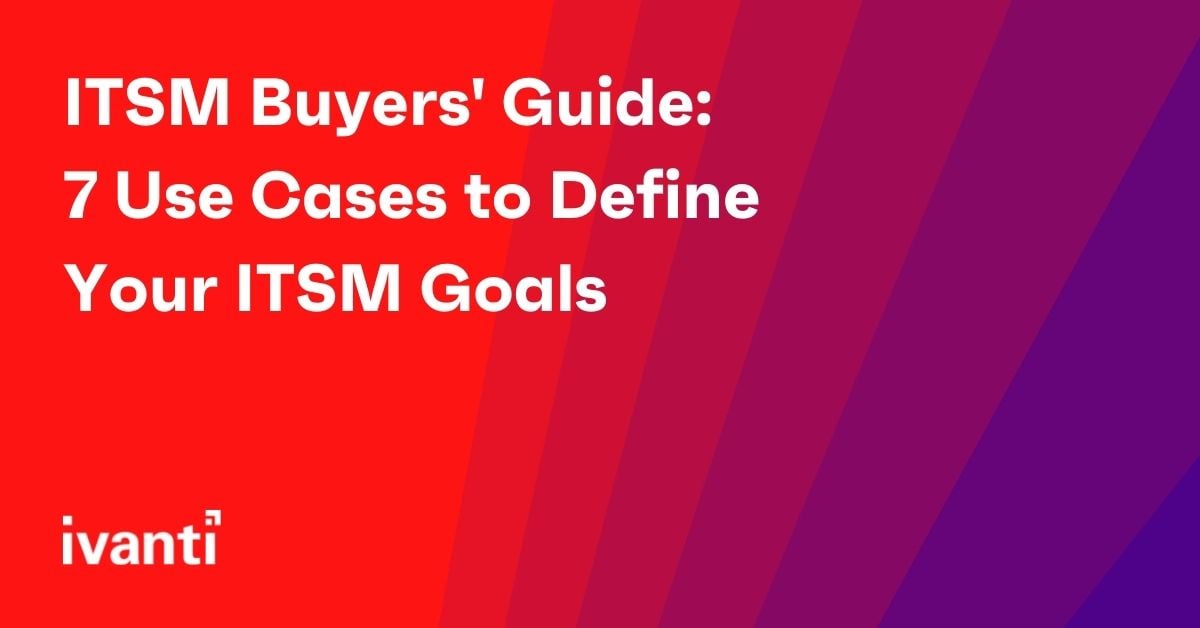ITSM Buyers' Guide: 7 Use Cases to Define Your ITSM Goals
Attempting an upgrade or switch to a new ITSM tool is obstacle-ridden for IT directors. From having to address fears surrounding the cost of switching vendors to assessing service management maturity, building a case around why and how an ITSM can advance the business can be a harrowing feat. Thankfully, Info-Tech pulled together this selection guide.
Namely, a substantial obstacle on that list is the dilemma of how to demonstrate value to stakeholders and gain buy-in. There’s a common perception that IT solutions only cost the company money, making approval for ITSM upgrades extremely difficult to achieve.
But IT is much more than just a provider of technology—with the right solutions, it has the power to break down barriers between department silos and connect processes for a more seamless experience both end-users and technicians can get behind. To really show the value of a solution, IT directors must go deeper into the actual benefits ITSMs bring and align them with business interests that can win over stakeholders. Learn how to show this value in Info-Tech’s “IT Service Management Selection Guide.”
Defining Use Cases Helps to Build a Business Case
According to research done by Apptio, seventy-seven percent of CIOs have trouble articulating true application costs, yet this is the key to getting a yes1. Defining use cases is an effective method for expressing costs and benefits essential to growth. Well-defined use cases provide a clear and concise view into nearly every facet of the project, from business and technical drivers and the current state of the system to funding and whatever risks might hinder progress.
Successful deployment of use cases can result in improved operational efficiency, customer satisfaction, and compliance—benefits that are typically central to IT interests. On the other hand, revenue generation rate, cost reductions, and an increase in net income are what matter most to stakeholders. With these key objectives in mind, developing a business case based on how each feature will be used can help to deliver a sound argument fully illustrating where solutions are needed most and how to achieve results that attract the eye of stakeholders.
Once your team has identified high-level goals, take a look at how these seven use cases can help to narrow down essential features and accelerate the ITSM selection process.
- Enterprise service management
- Customer-centric services
- Customer-support management
- IT finance
- Product owner management
- IT operations management
- Incident management
1. Enterprise Service Management
Businesses are seeing the value of extending their service management solutions outside IT to other departments. In fact, according to a report done by HDI that examined how organizations benefited from investing in enterprise service management (ESM) software, 75% of businesses saw an increase in productivity after expanding their services outside IT2. From human resources and corporate operations to facilities and customer support, ESM solutions enable automated workflows, organize incident and service requests, and centralize resources.
Investment in ESM makes a huge impact on productivity with numerous business outcomes like increased employee satisfaction, higher visibility into workflows, informed risk mitigation, and a lower total cost of ownership (TCO).
To identify features that meet this use case, look into the following areas:
- Self-service features
- Service and solutions design
- Knowledge and reporting
2. Customer-Centric Services
Customer-centric services are a major driver for upgrading or switching ITSM solutions. Companies hope to provide a larger variety of offerings that keep their customers engaged throughout multiple levels of the sales funnel. Through this method, customers are invited to peruse resources and address common issues through a personalized portal or web space designed just for them. By offering more self-service options, content management features, and speedier service and product delivery, customer-centric services give greater transparency and ultimately boost the customer experience.
Technicians also get a win here with businesses reporting a 52% increase in employee satisfaction since expanding service management outside of IT3. Thanks to a more streamlined system, customer service technicians have more time, allowing them to enhance processes and identify areas for improvement.
To meet this use case, research the following areas:
- Self-service features
- Service and solutions design
- Knowledge and reporting
- Technician usability features
3. Customer Support Management
In a recent study by Hubspot, although only 42% of the companies surveyed used help desk systems for customer service, 86% of them reported that the software gave them an increase in productivity4. This informs us of the value a dedicated customer relationship management (CRM) system can bring to support teams. CRMs position businesses to provide the highest level of support by giving them access to accurate and timely reporting with triage solutions and dashboards that make it easy to keep a pulse on clients and client data. It’s a wonder more companies aren’t making the investment.
Depending on the type of support offered to external clients, an ITSM solution or a CRM add-on could be the answer. For instance, if first-contact resolutions are the primary practice, an integration that extends CRM capabilities may be appropriate, whereas for an omnichannel approach, an ITSM solution might be a better fit.
To support this use case, take a look at the following areas:
- Service and solutions design
- Knowledge and reporting
- Technician usability features
- Incident management
4. IT Finance
A study by Apptio showed that directors of IT who present defensible insights into IT finances save up to 10% on costs5. Having more visibility into finances allows IT directors to quickly analyze budget deviations and extrapolate day-to-day costs from innovative expenditures. With greater visibility into capital (CapEx) and operating expenses (OpEx), companies acquire a new strategic tool for their arsenal with clear, discernible data that can be used to guide decisions about how services are funded.For features that support this use case, look into these areas:
- Service and solutions design
- Reporting and analysis
- Technician usability features
- Asset management for IT finance
- Configuration management features
5. Product Owner Management
Businesses today are being tasked to meet operations needs with even greater agility and collaboration across departments. This mindset is certainly evolving the philosophy behind how teams work, creating a more product-focused environment directed toward managing the entire lifecycle of an application.
Supporting DevOps or site reliability engineering (SRE) is a pertinent business case to make, with 84.3% of tech professionals reporting that their ability to innovate is greatly affected by customer-impacted issues6. To influence ITSM maturity, businesses will need to invest in improved workflows and communications with integrations, automated testing, and infrastructure provisioning.
Look to the following areas to identify features to meet this use case:
- Service and solutions design
- Knowledge and reporting
- Development and project management
- Problem management
- Change and configuration management
- Incident and event management
6. IT Operations Management
Automation and reporting is a large part of maturing operations and positioning your organization for growth. Successfully managing IT operations hinges on accurately detecting larger underlying issues and minimizing recurring incidents.
What holds companies back from achieving a maturity in their systems can be as simple as relying too much on manual processes and not investing enough in automation. According to a report by ScienceLogic, organizations saw a 70% reduction in their mean time to recovery (MTTR) and manual troubleshooting effort when using automation instead of manual processes7.
Try looking into the following areas to meet this use case:
- Service and solutions design
- Knowledge and reporting
- Technician usability features
- Problem management
- Change and configuration management
- Incident and event management
With more visibility into operations, IT teams can better monitor automation and performance while having the capability to prevent as well as respond to outages and other events. Features that focus on IT operations management also accelerate the speed of analysis and decrease response times.
7. Incident Management
Addressing issues in real time is a constant concern for businesses looking to improve their incident management solution. As end-users increase the demand for more immediate, high-touch results, technicians are being called to respond faster and resolve incidents in fewer interactions. In a recent study done by Ivanti, up to 80% of endpoint issues were resolved by self-healing technology before users even reported them8. By investing in solutions that allow for self-service, end users are provided quick solutions without having to wait for a technician to respond.
To identify features that meet this use, look into the following areas:
- Self-serve features
- Service and solutions design
- Knowledge and reporting
- Technician usability features
- Asset management
- Problem management
With the right incident management system, both end-users and technicians will be empowered to resolve issues on their own at a faster rate while also reducing recurring incidents.
Build Your Vendor List Based on the Features That Matter Most
From here, take stock of the features that best align with your use cases and develop your list of requirements. Vendors that meet your highest requirements should make the cut as your team narrows in on a final decision. Also, be sure to set realistic timelines. By highlighting project milestones, it will be easier to recognize and articulate the metrics for success and keep stakeholders engaged.
Building a business case for your ITSM goals is a large undertaking with many moving parts that may distract from the vision so try to stay close to the core use cases and features that matter most to your organization’s growth. When done right, well-defined use cases should help IT directors discuss and defend their choice of solutions and make the ITSM selection process clear and effective for all parties.
Want to learn more about how to get your team on board?
Take a deep dive into the Info-Tech report for more details on the costs of inertia and the best strategy for switching vendors.
[1] “100 IT Cost Reduction Questions You Should be Asking.” Apptio Inc. 2020
[2] “The State of Enterprise Service Management.” HDI and Samanage, November 2018. Web.
[3] “The State of Enterprise Service Management.” HDI and Samanage, November 2018. Web.
[4] “The State of Customer Service in 2020.” Hubspot, July 2020.
[5] “100 IT Cost Reduction Questions You Should be Asking.” Apptio Inc. 2020
[6] “The State of Automation in Incident Management.” xMatters, 2020.
[7] “Reduce MTTR by Automating Troubleshooting.” ScienceLogic 2020.
[8] Ivanti, 2020.

